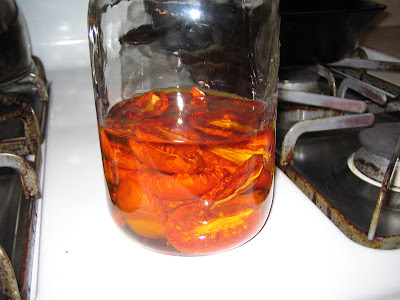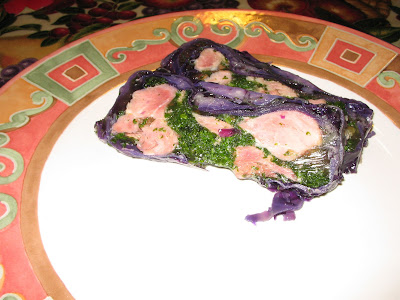
Fillet of fenny snake,
In the caldron boil and bake;
Eye of newt, and toe of frog,
Wool of bat, and tongue of dog,
Adder's fork, and blind-worm's sting,
Lizard's leg, and owlet's wing, --
For a charm of powerful trouble,
Like a hell-broth boil and bubble
Double, Double, toil and trouble;
Fire burn, and caldron bubble
Part of three witches speech from Macbeth
While making last night's dinner, I felt a little like these three witches. Eye of newt? Check. Wool of bat? Check. Owlet's wing? Check. None of these really went into my pot, but what did go into my pot was chicken hearts and gizzards. I found a recipe last week in Tom Valenti's Soups, Stews and One-Pot meals and knew I had to try it. I had actually touched a chicken heart before when I pulled the innards out of chicken before cooking it. I would usually throw it in a pot with the backbone to make a quick stock. But the gizzards were a totally new and somewhat creepy thing to me. "What is a gizzard?" you may ask? A gizzard is part of the digestive system of birds. It is used to grind up food and pass it back into the bird's true stomach (at least that is how I understand it) They are a fairly thick and strong muscle which benefit from a long cooking time.
Surprisingly, chicken hearts and gizzards were sold together in a 1 1/2 lb. package right next to the chicken breasts and legs at the supermarket. Plus, they were cheap. The whole package cost $1.50. I had to buy two packages for this meal but the whole huge pot of sauce plus all of the other dinner fixings made enough to serve four adults and two children for at least three meals and probably cost about $10.
Surprisingly, chicken hearts and gizzards were sold together in a 1 1/2 lb. package right next to the chicken breasts and legs at the supermarket. Plus, they were cheap. The whole package cost $1.50. I had to buy two packages for this meal but the whole huge pot of sauce plus all of the other dinner fixings made enough to serve four adults and two children for at least three meals and probably cost about $10.
"Okay, so they are cheap, and apparently edible, but how do they taste?" I can hear you asking. The sauce in this dish was phenomenal and if you are used to hearts and gizzards, you are going to love it. If you are not used to them, as I was not, the chewiness may take you a bit to get past, but they are very rich and satisfying if you don't mind the chew. Try something new and maybe a little creepy, you'll be pleasantly surprised. Happy Halloween everyone.
Chicken Hearts and Gizzards in Italian-Style Tomato Sauce adapted from Tom Valenti's Soups, Stews, and One-Pot Meals
Serves at least 8
1/3 cup olive oil
3 lbs. chicken hearts and gizzards
Coarse salt
Freshly ground black pepper
2 medium carrots, peeled and cut into 1/2 inch dice
1 large onion, peeled and cut into 1/2 inch dice
6-8 cloves of garlic, peeled and minced
1/4 cup tomato paste
1/2 cup dry white wine
3- 15oz. cans of chopped tomatoes with their juices
1 cup water
1/4 cup extra-virgin olive oil
2 bay leaves
1 Tbls. dried basil
1 1/2 tsp. dried thyme
1/2 tsp. crushed red pepper
Instructions:
1. Heat 1/3 cup olive oil in a large, heavy-bottomed pot over medium-high heat. Add the hearts and gizzards, season with salt and pepper, and brown on all sides, 3 to 4 minutes. Transfer the hearts and gizzards to a plate and set aside.
2. Add the carrots, onion and garlic to the pot and cook, stirring, until softened but not browned, about 5 minutes. Add the tomato paste, stir to coat the other ingredients, and cook for 2 to 3 minutes. Add the white wine, bring to a boil and let reduce for 2 minutes.
3. Add the tomatoes, water, extra-virgin olive oil, bay leaves, basil, thyme and crushed red pepper. Stir, return the hearts and gizzards to the pot, raise the heat and bring to a boil. Season with salt and pepper, lower the heat and simmer gently for 90 minutes until nicely thickened and richly flavored. Remove the bay leaves.
4. Serve over toasted bread, pasta, or polenta.






















